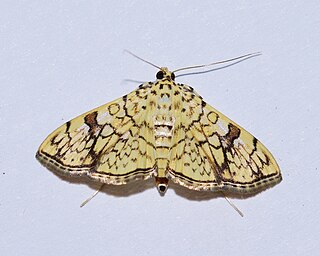| Ambia chalcichroalis | |
|---|---|
| Scientific classification | |
| Domain: | Eukaryota |
| Kingdom: | Animalia |
| Phylum: | Arthropoda |
| Class: | Insecta |
| Order: | Lepidoptera |
| Family: | Crambidae |
| Genus: | Ambia |
| Species: | A. chalcichroalis |
| Binomial name | |
| Ambia chalcichroalis Hampson, 1906 | |
Ambia chalcichroalis is a moth in the family Crambidae. It was described by George Hampson in 1906. [1] It is found in South Africa. [2]
The wingspan is about 18 mm. The forewings are bronze yellow suffused in parts with fuscous and with an antemedial white band, defined by black formed by a bar from the costa to the median nervure, and an oblique wedge-shaped patch from the cell to the inner margin. There is a small white discoidal lunule defined by black and a postmedial white band defined by black from the costa to vein 4, its inner edge sinuous and expanding at and below the costa. There is also a conical white patch defined by black from below the end of the cell to the inner margin and a subterminal white band defined by black and excurved and interrupted at the middle. The hindwings are bronze yellow suffused in parts with fuscous and with an ill-defined white subbasal band and an antemedial quadrate white patch defined by black from the costa to the median nervure, with a narrow white band defined by black from it to the inner margin and a postmedial curved white band defined by black from the costa to vein 4, its inner edge sinuous and expanding at and below the costa. There is also a curved white band defined by black from below the end of the cell to the inner margin and a subterminal maculate white band defined by black formed by a subapical spot. There are three conjoined spots between veins 7 and 4 and two spots towards the tornus. [3]

